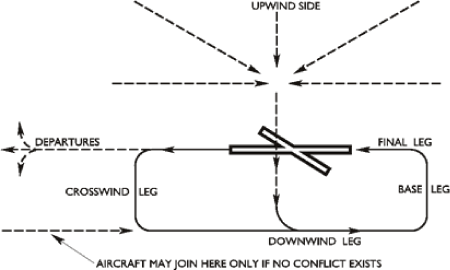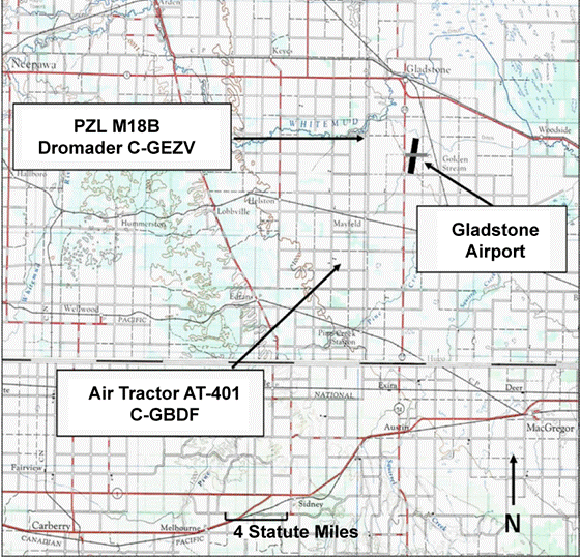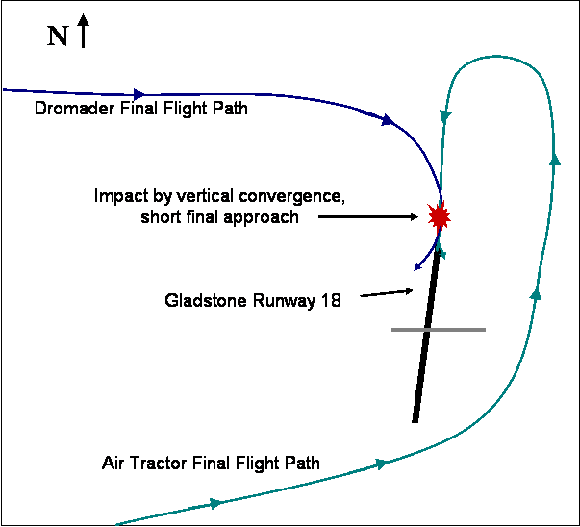In-Flight Collision
Glad Air Spray
Pezetel M18B Dromader, C-GEZV and
Air Tractor AT-401, C-GBDF
Gladstone, Manitoba
The Transportation Safety Board of Canada (TSB) investigated this occurrence for the purpose of advancing transportation safety. It is not the function of the Board to assign fault or determine civil or criminal liability. This report is not created for use in the context of legal, disciplinary or other proceedings. See Ownership and use of content. Masculine pronouns and position titles may be used to signify all genders to comply with the Canadian Transportation Accident Investigation and Safety Board Act (S.C. 1989, c. 3).
Summary
Two Glad Air Spray aerial application aircraft were conducting independent flights in the vicinity of Gladstone, Manitoba. The Pezetel M18B Dromader (registration C-GEZV, serial number 1Z027 10) was returning from an aerial application flight about 20 nautical miles (nm) west of the Gladstone aerodrome. The Air Tractor AT-401, (registration C-GBDF, serial number 401-0866), was returning from an aerial application flight in the vicinity of Carberry, Manitoba, about 25 nm southwest of the Gladstone aerodrome.
Both aircraft approached Runway 18 at Gladstone. On final approach, the Dromader descended and struck the Air Tractor from above. Both aircraft descended to the ground and crashed. The Air Tractor was destroyed by impact forces and fire. The Dromader was substantially damaged. The Dromader pilot was not injured; the Air Tractor pilot received serious burn injuries. The accident occurred during daylight hours at 1900 central daylight time.
Other Factual Information
Gladstone (CJR5) is a registered aerodrome located three nautical miles (nm) south of the town of Gladstone, Manitoba. The main runway at the aerodrome is Runway 18/36, which measures 2695 feet long by 95 feet wide and has a paved surface. Runway 08/26 measures 2050 feet by 75 feet and has a grass surface. The aerodrome does not have a control tower or flight service station and the airspace above it is uncontrolled at the altitudes flown by the occurrence aircraft. There is no mandatory communications frequency for Gladstone; however, an aerodrome traffic frequency (ATF) of 122.8 Mhz is specified for the aerodrome area.
The Pezetel M18B Dromader (Dromader) pilot was monitoring the ATF during the approach, but did not make or receive any traffic calls. The Air Tractor AT-401 (Air Tractor) had been equipped with a communications radio, but it had been removed for repair in the spring of 2009. Glad Air Spray had an office equipped with a communications radio at the aerodrome, but the office was unoccupied at the time of the accident. Glad Air Spray's Director of Flight Operations (DFO) observed the aircraft returning to the airport from their flights. He was working at a tank facility located adjacent to the office, where he was mixing spray chemical to reload into the returning aircraft.
The Air Tractor had been operating near Carberry, Manitoba, earlier in the day. It remained at Carberry mid-day, and then completed a flight as winds subsided in the early evening. Returning to Gladstone, the Air Tractor approached the aerodrome from the southwest, crossed just south of Runway 18/36, and joined the circuit on a left downwind leg for Runway 18, at about 500 feet above ground level (agl).Footnote 1 The Dromader approached from the west and joined the circuit directly on a descending right base leg, also for Runway 18, starting at about 1000 feet agl. Both aircraft turned onto final approach for Runway 18 and proceeded towards the runway. The aircraft collided on short final, with the Dromader positioned slightly above the Air Tractor.Footnote 2 Neither pilot saw the other aircraft until the collision.
The forward fuselage and engine area of the Air Tractor was damaged by the propeller of the Dromader during the in-flight collision. The Air Tractor pilot lost control of his aircraft, which crashed in a near-vertical attitude on the asphalt surface of the approach end of Runway 18. The aircraft overturned after impact and came to rest in an inverted position at the side of the runway. A fuel-fed fire ensued almost immediately. The pilot was able to exit the aircraft and crawl away from the burning wreckage. The aircraft was destroyed by impact forces and fire.
After the collision, the Dromader pilot also lost control of his aircraft, which crashed at a shallow angle in a marsh west of the approach end of Runway 18. The aircraft sustained substantial damage to its wings and propeller. The Dromader pilot was not injured, and he exited the aircraft and went to assist the pilot of the Air Tractor. The DFO observed the collision and the crash of both aircraft, drove his truck to the scene to assist the pilots, and transported the Air Tractor pilot to hospital. The fire consumed much of the Air Tractor's fuselage and wing roots before any attempt could be made to bring it under control. The fire consumed the aircraft's fuel supply within several minutes and then subsided.
Both aircraft were single-pilot, low-wing monoplanes designed for aerial application operations. Both aircraft were equipped with radial engines and spray chemical hoppers located between the pilot and the engine. The cockpits of both aircraft are protected by robust structures designed to absorb impact without compromising occupant living space. The Air Tractor had an overall length of 27 feet (8.23 metres (m)), a wingspan of 45 feet (13.75 m), a maximum take-off weight of 7200 pounds (3263 kilograms (kg)), and was painted yellow.
The Dromader had an overall length of 31 feet (9.47 m), a wingspan of 58 feet (17.70 m), a maximum take-off weight of 11 700 pounds (5307 kg), and was painted white and yellow. The nose of the Dromader is about 58 inches wide and extends over 160 inches forward from the pilot's position in the cockpit. Both aircraft were equipped with landing lights; however, they were not selected ON at the time of the accident. Both aircraft were returning from discharging their loads of chemical and were operating at relatively light weights. There were no mechanical discrepancies found with either aircraft that would have contributed to the occurrence.
Both pilots were wearing helmets and the five-point, occupant restraint harnesses installed in each of the aircraft. The pilot of the Dromader was wearing a short-sleeved shirt and gloves; the Air Tractor pilot was wearing a short-sleeved shirt and not wearing gloves. Both pilots were able to operate the release mechanisms of the harnesses and open the aircraft exit doors, unassisted, after the accident.
The aviation weather report for Brandon, Manitoba, 43 nm southwest of Gladstone, for 1900,Footnote 3 was as follows: winds 130° True (T) at 10 knots, visibility 15 statute miles (sm), broken cloud at 15 000 feet above ground level (agl), overcast cloud at 25 000 feet agl, temperature 19°C, and dew point 10°C. The cloud base was well above the flight path of the aircraft and visibility was unlimited.
Neither pilot was aware of the presence of the other aircraft in the vicinity of Gladstone, nor was either pilot expecting the other aircraft to be there. Both aircraft were operating under visual flight rules (VFR). Safe VFR flight is predicated on the see-and-avoid concept and on procedures to ensure aircraft separation during an approach to an aerodrome. The effectiveness of the see-and-avoid concept for collision avoidance is dependent on flight crew detecting other aircraft in time to take evasive action. A pilot's ability to visually detect another aircraft is affected by many factors, including physiological limitations of the human visual and motor response systems, the pilot's awareness of the presence of another aircraft, the pilot's available field of view and obstructions to that field of view, aircraft conspicuity, pilot scanning techniques, and pilot workload.
The Canadian Aviation Regulations (CARs)Footnote 4 specify that before landing at an aerodrome, the pilot of an aircraft shall conform to or avoid the pattern of traffic formed by other aircraft in operation there, give way to any aircraft at a lower altitude that is also approaching the aerodrome for the purpose of landing, and make all turns to the left when operating within the aerodrome traffic circuit, except where right turns are specified. Transport Canada Aeronautical Information Manual, section RAC 4.5.2, Traffic Circuit Procedures - Uncontrolled Aerodromes, states the following:
Unless otherwise specified or required by the applicable distance from cloud criteria, aircraft should approach the traffic circuit from the upwind side. Alternatively, once the pilot has ascertained without any doubt that there will be no conflict with other traffic entering the circuit or traffic established within the circuit, the pilot may also join the circuit on the downwind leg [Figure 1]. When joining from the upwind side, plan the descent to cross the runway in level flight at 1000 feet above aerodrome elevation or the published circuit altitude. Maintain that altitude until further descent is required for landing.
It is generally recognized that traffic advisories improve a pilot's ability to visually acquire another aircraft. The advisory provides advance warning of a potential conflict and will tend to increase the time that a crew will devote to a visual search for the traffic, as well as aiding a pilot in concentrating a visual search in the proper direction.
The pilots of both aircraft had current medical certificates and there was no indication that any physiological factors affected their ability to conduct the flights safely. The Air Tractor pilot had a valid commercial pilot licence with about six years of experience in aerial application flight. He had about 1400 hours of total flight time with about 700 hours on the Air Tractor. The Dromader pilot had a valid commercial pilot license with more than 15 years of experience in aerial application flight. He had about 10 000 hours of total flight time with more than 1000 hours on the Dromader. Both pilots had flown on the morning of the occurrence, but had been off duty during the mid-day. They began flight operations again at about 1600, three hours before the occurrence. Both pilots had several days of rest before the day of the occurrence and neither reported indications of fatigue. Both aircraft had been spraying Follicure fungicide, which was not considered hazardous to the pilots involved in the application flights.
Glad Air Spray was based at Gladstone and operated under a Transport Canada Air Operator Certificate authorizing aerial work (Subpart 702 of the CARs). Glad Air Spray operated two Air Tractors, one Dromader, one Cessna 188, and one Grumman G-164. Its operations manual required the company to provide initial and annual recurrent flight crew training and to certify the competency of its pilots on topics including the CARs, aircraft surface contamination, aircraft systems and servicing, and emergency procedures. For pilots with more than 100 hours of experience within the last three years, 2 hours of annual recurrent ground training was required to ensure a pilot's continued level of competency. No documented recurrent ground training was completed in 2009. One hour of annual recurrent aircraft flight training was required, on topics including pre-flight, pre-take-off, take-off, in-flight manoeuvres, aerial application techniques, landing, and emergency procedures. In the spring of 2009, the accident pilots completed annual recurrent flight training. No record was kept as to the details of this training and no pilot competency check documents were issued.
Transport Canada advised that, as a matter of policy, it does not audit or inspect the operations of air operators engaged in aerial work operations.
Analysis
The Dromader pilot joined the circuit for Runway 18 on a right base leg, contrary to the recommended aerodrome traffic procedure. This compromised his opportunity to observe other traffic in the area and join the circuit without conflict with other traffic.
The Dromader's flight path made it difficult for the Air Tractor pilot to see the Dromader, although both were approaching the same runway. The Dromader was head-on to the Air Tractor, while the latter aircraft was on much of the downwind and base legs of its approach, in which position the Dromader's conspicuity was low. The Dromader's profile would have been that of the engine and the leading edges of the wings and tail, and would not have displayed its brightly painted fuselage. Its relative lateral movement to the Air Tractor was minimal and it would not have drawn the Air Tractor pilot's attention. Neither of the pilots was expecting other aircraft to be in the circuit and neither pilot used landing lights to increase his aircraft's conspicuity. The Air Tractor pilot could not, and the Dromader pilot did not make or receive traffic calls on the ATF. This reduced their ability to gain situational awareness of the traffic in the area.
The Dromader's nose was large enough to obscure its pilot's view of a significant area ahead of and underneath the Dromader. In the right turn onto final approach, the area which was obscured likely kept pace with the flight path of the Air Tractor while the two aircraft lined up on final approach. Although both aircraft were substantial in size, were painted in conspicuous colours, and the weather was favourable, the relative positions of the aircraft would have made each difficult for the other pilot to detect. The pilot of the Dromader would have had to make clearing turns to observe the area under the aircraft's nose, and because the pilot believed there was no local traffic, no such turns were made. After the Dromader turned onto final approach, its flight path converged with that of the Air Tractor. As it descended, it struck the Air Tractor and both aircraft descended to the ground out of control.
Both pilots were wearing five-point harnesses and helmets. The helmets reduced the likelihood of head injury during the crash, and the restraint systems in both aircraft functioned as designed. Together, these systems allowed both pilots to survive significant deceleration forces on impact without serious injury and then exit their aircraft. The cockpit structures of both aircraft maintained sufficient integrity to allow both pilots to open their respective cockpit doors without difficulty. In particular, the Air Tractor maintained its cockpit integrity after its near-vertical impact onto a hard surface, and its inverted position after the crash. The pilot was able to release his restraint system, open the cockpit door, and escape a fire that was already in progress. The Air Tractor pilot's arms and hands were not protected against fire, which likely increased the extent of his injuries. The fire consumed most of the aircraft before a response could be organized.
The operator's training program was not implemented as required by its operations manual. Portions of the program related to circuit procedures and traffic avoidance could have reduced the risk of collision by emphasizing appropriate circuit procedures. Glad Air Spray did not help its pilots enhance their situational awareness by maintaining communications radios capable of making and receiving calls on the Gladstone ATF.
Transport Canada's oversight policy eliminated an opportunity to evaluate Glad Air Spray's operation to suggest improvements to the operation and to ensure that the required standards were maintained. Glad Air Spray was not proactive in reducing the risks that these standards were designed to address.
Findings
Findings as to causes and contributing factors
- The Dromader pilot joined the circuit for Runway 18 in a manner that compromised his opportunity to observe, conform to, and avoid conflict with the pattern of other traffic in the circuit.
- The Dromader's flight path and lack of conspicuity made it difficult for the Air Tractor pilot to see the Dromader's approach and avoid the impending conflict.
- The Dromader's nose likely obscured an area which kept pace with the Air Tractor flight path while the two aircraft converged on final approach. The Dromader pilot did not make clearing turns to observe the area under his aircraft's nose and this made it difficult for him to see the Air Tractor's approach and avoid the impending conflict.
- On final approach, the Dromader's flight path converged horizontally and then vertically with that of the Air Tractor, until the Dromader struck the Air Tractor and both aircraft descended out of control to the ground.
- The non-use of landing lights and lack of radio communication contributed to the pilots' reduced awareness of traffic in the area.
- The Air Tractor pilot's arms and hands were not protected, which likely increased the extent of the injuries resulting from the post-crash fire.
- The operator's training program was not implemented as required, and provisions in the required training designed for avoiding in-flight collisions were not completed.
- Transport Canada does not audit or inspect air operators engaged in aerial work operations and therefore cannot evaluate operator procedures, suggest improvements, or ensure that the required training is completed.
Other findings
- The use of a five-point harness and helmet reduced the likelihood of injury during the crashes and allowed the pilots to survive significant deceleration forces and exit the aircraft.
- The cockpit structures of both aircraft maintained their integrity to allow the pilots to open their respective cockpit doors and exit the aircraft. In particular, the Air Tractor maintained its cockpit integrity after a near-vertical impact onto a hard surface, which allowed its pilot to open the cockpit door and exit the aircraft.
This report concludes the Transportation Safety Board's investigation into this occurrence. Consequently, the Board authorized the release of this report on .


